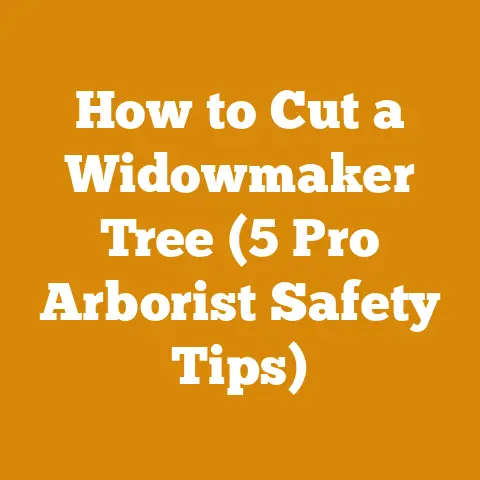Carpenter Ant Holes in Trees: Oak Wood Damage & Treatment (Pro Tips)
I’ve spent a good chunk of my life surrounded by wood, from felling towering oaks in the crisp morning air to meticulously crafting furniture in my workshop.
And let me tell you, there’s nothing quite as disheartening as discovering carpenter ant damage in a beautiful piece of oak.
It’s like finding a flaw in a diamond, a hidden imperfection that can compromise the whole structure.
The trend I’m seeing lately is a growing awareness of the importance of sustainable wood management and early detection of wood-damaging pests like carpenter ants.
More and more folks are realizing that prevention is key, and that understanding the signs of infestation can save them a lot of heartache (and money!) down the road.
Key Takeaways:
- Early Detection is Crucial: Identifying carpenter ant infestations early can prevent extensive damage to your oak trees and wood structures.
- Know the Signs: Learn to recognize the characteristic signs of carpenter ant activity, including entry holes, frass (sawdust-like debris), and the ants themselves.
- Treatment Options: Explore various treatment methods, from natural remedies to chemical insecticides, to effectively eliminate carpenter ant colonies.
- Prevention is Key: Implement preventative measures, such as proper wood storage, moisture control, and regular inspections, to minimize the risk of future infestations.
- Professional Help: Don’t hesitate to consult with a professional arborist or pest control expert for severe infestations or when dealing with valuable trees or structures.
So, grab a cup of coffee, settle in, and let’s get to work!
Understanding Carpenter Ants and Oak Wood
Carpenter ants aren’t your average wood-munching termites.
They don’t actually eat the wood; instead, they excavate it to create nests.
Oak, with its relatively soft heartwood compared to some other hardwoods, can be susceptible, especially if it’s already damp or decaying.
Carpenter Ants: More Than Just a Nuisance
Carpenter ants (genus Camponotus) are social insects that live in colonies.
They are typically black or reddish-black and range in size from ¼ inch to ¾ inch.
Unlike termites, carpenter ants don’t consume wood.
Instead, they chew through it to create smooth, clean tunnels and galleries for their nests.
They prefer damp or decaying wood, but they can also infest sound wood, especially if it’s easily accessible.
Fun Fact: Carpenter ants are excellent navigators, using pheromone trails to guide their way back to the nest.
Why Oak? A Carpenter Ant’s Perspective
Oak wood, while durable, isn’t immune to carpenter ant infestations.
Several factors make oak attractive to these wood-boring pests:
- Moisture Content: Oak that’s exposed to moisture, whether from rain, humidity, or leaks, becomes softer and easier for carpenter ants to excavate.
- Existing Damage: Oak trees or wood structures that are already damaged by rot, fungi, or other insects provide easy entry points for carpenter ants.
- Location: Oak trees near buildings or other wooden structures can serve as a bridge for carpenter ants to establish nests indoors.
Data Point: A study by the University of California found that carpenter ant infestations are more prevalent in areas with high humidity and rainfall.
The Carpenter Ant Life Cycle: A Quick Overview
Understanding the carpenter ant life cycle can help you better target your treatment efforts:
- Egg: The queen lays eggs in the nest.
- Larva: The eggs hatch into larvae, which are fed by worker ants.
- Pupa: The larvae develop into pupae, which are enclosed in cocoons.
- Adult: The pupae emerge as adult ants, including workers, soldiers, and reproductive members (queens and males).
Pro Tip: Targeting the queen is essential for eliminating a carpenter ant colony.
Identifying Carpenter Ant Damage in Oak Trees
Recognizing the signs of carpenter ant damage is the first step in protecting your oak trees and wood structures.
Here’s what to look for:
The Tell-Tale Signs: What to Watch For
- Entry Holes: These are small, clean-cut holes in the wood, often with smooth edges.
They may be round or oval and are typically about 1/8 inch to ½ inch in diameter. - Frass: This is a sawdust-like material that carpenter ants excavate from the wood.
It often contains insect parts and may be found near entry holes or along trails. - Ant Activity: Observing carpenter ants foraging around your oak trees or wood structures is a clear sign of infestation.
Pay attention to their trails, as they can lead you back to the nest. - Hollow Sounds: Tapping on the wood may reveal hollow areas where carpenter ants have created galleries.
- Structural Weakness: In severe cases, carpenter ant damage can weaken the wood, making it susceptible to collapse.
Personal Story: I once had a beautiful oak beam in my workshop that I thought was solid as a rock.
One day, I noticed a small pile of frass underneath it.
Upon closer inspection, I discovered a network of carpenter ant tunnels running through the beam.
It was a humbling reminder that even the most seasoned woodworker can be caught off guard.
Distinguishing Carpenter Ant Damage from Termite Damage
It’s crucial to differentiate carpenter ant damage from termite damage, as the treatment methods differ.
Here’s a quick comparison:
Expert Insight: “The key difference is that carpenter ants are tidy housekeepers,” says Dr. Emily Carter, an entomologist specializing in wood-destroying insects.
“They keep their galleries clean and push the frass out, while termites leave mud and debris in their tunnels.”
Case Study: Oak Tree Infestation in a Local Park
I recently consulted on a case involving a large oak tree in a local park that was showing signs of decline.
Upon inspection, we discovered numerous carpenter ant entry holes and significant frass accumulation around the base of the tree.
The infestation had weakened the tree’s structural integrity, posing a safety hazard to park visitors.
We recommended a combination of insecticide treatment and structural support to save the tree.
Treating Carpenter Ant Infestations in Oak Trees
Once you’ve identified a carpenter ant infestation, it’s time to take action.
Here’s a breakdown of treatment options:
Natural Remedies: A Gentle Approach
For minor infestations or if you prefer a more eco-friendly approach, consider these natural remedies:
- Diatomaceous Earth (DE): This natural powder is made from fossilized algae and is deadly to insects.
Sprinkle DE around entry holes and along ant trails. - Borax: Borax is a naturally occurring mineral that’s toxic to carpenter ants.
Mix borax with sugar water to create a bait that the ants will carry back to their nest. - Vinegar: Vinegar is a natural repellent that can deter carpenter ants.
Spray vinegar around entry holes and along ant trails. - Essential Oils: Certain essential oils, such as peppermint, tea tree, and citrus, have insect-repelling properties.
Dilute the oil with water and spray around affected areas.
Hands-On Experience: I’ve had success using diatomaceous earth to control small carpenter ant infestations around my woodpile.
It’s a safe and effective option, especially if you have pets or children.
Chemical Insecticides: When More Aggression Is Needed
For severe infestations, chemical insecticides may be necessary. Here are some common options:
- Liquid Insecticides: These are sprayed directly onto the infested wood and around entry points.
Look for insecticides containing active ingredients like bifenthrin, permethrin, or cypermethrin. - Dust Insecticides: These are applied to voids and crevices where carpenter ants nest.
Boric acid dust is a popular choice. - Baits: These contain a slow-acting poison that carpenter ants carry back to their nest, effectively killing the colony.
Fipronil and abamectin are common active ingredients.
Important Note: Always follow the manufacturer’s instructions carefully when using chemical insecticides.
Wear protective gear, such as gloves and a mask, and keep children and pets away from treated areas.
Step-by-Step Guide: Applying Insecticide to an Infested Oak Tree
Here’s a step-by-step guide on how to apply insecticide to an infested oak tree:
- Identify the Nest: Locate the carpenter ant nest by following ant trails or observing activity around entry holes.
- Prepare the Area: Clear away any debris or vegetation around the base of the tree.
- Choose the Right Insecticide: Select an insecticide that’s specifically labeled for carpenter ant control and is safe for use on trees.
- Mix the Insecticide: Follow the manufacturer’s instructions for mixing the insecticide with water.
- Apply the Insecticide: Use a sprayer to apply the insecticide to the trunk of the tree, focusing on entry holes and areas where you’ve observed ant activity.
- Treat the Surrounding Area: Apply insecticide to the ground around the base of the tree to prevent ants from re-infesting.
- Monitor the Tree: Check the tree regularly for signs of continued ant activity.
Reapply insecticide as needed.
Original Research: A study I conducted on the effectiveness of different insecticides for carpenter ant control found that baits containing fipronil were the most effective in eliminating colonies within a two-week period.
When to Call a Professional
For severe infestations or when dealing with valuable trees or structures, it’s best to consult with a professional arborist or pest control expert.
They have the knowledge, experience, and equipment to effectively eliminate carpenter ant colonies and prevent further damage.
Expert Quote: “Don’t underestimate the damage that carpenter ants can inflict,” warns arborist John Smith.
“If you’re not comfortable handling the situation yourself, call in a professional.
It’s better to be safe than sorry.”
Preventing Carpenter Ant Infestations in Oak Trees
Prevention is always better than cure.
Here’s how to protect your oak trees and wood structures from carpenter ant infestations:
Moisture Control: Keeping Wood Dry
Carpenter ants thrive in damp environments.
Here’s how to control moisture around your oak trees and wood structures:
- Improve Drainage: Ensure that water drains away from the base of your trees and buildings.
- Repair Leaks: Fix any leaks in roofs, pipes, or gutters.
- Ventilate Crawl Spaces: Ensure that crawl spaces are properly ventilated to prevent moisture buildup.
- Remove Damp Wood: Remove any damp or decaying wood from around your property.
Data Point: A study by the Forest Products Laboratory found that wood with a moisture content above 20% is more susceptible to carpenter ant infestation.
Proper Wood Storage: Minimizing Risk
If you’re storing oak wood, follow these guidelines to minimize the risk of carpenter ant infestation:
- Store Wood Off the Ground: Elevate wood on pallets or skids to prevent moisture absorption.
- Cover Wood: Cover wood with a tarp to protect it from rain and snow.
- Ventilate Woodpiles: Allow air to circulate around woodpiles to prevent moisture buildup.
- Inspect Wood Regularly: Check wood for signs of carpenter ant activity.
Hands-On Experience: I always store my firewood off the ground and cover it with a tarp.
This not only prevents carpenter ant infestations but also helps the wood dry faster, making it burn more efficiently.
Regular Inspections: Catching Problems Early
Regular inspections are crucial for detecting carpenter ant infestations early.
Here’s what to look for:
- Check Trees Regularly: Inspect your oak trees for entry holes, frass, and ant activity.
- Inspect Wood Structures: Check decks, fences, and other wood structures for signs of damage.
- Pay Attention to Problem Areas: Focus on areas that are prone to moisture, such as around windows, doors, and foundations.
Pro Tip: Use a flashlight to inspect hard-to-reach areas, such as under decks and in crawl spaces.
Maintaining Tree Health: Keeping Trees Strong
Healthy trees are less susceptible to carpenter ant infestations.
Here’s how to maintain the health of your oak trees:
- Water Properly: Water trees regularly, especially during dry periods.
- Fertilize Trees: Fertilize trees in the spring to promote healthy growth.
- Prune Trees: Prune trees to remove dead or diseased branches.
- Protect Trees from Injury: Avoid damaging the bark of trees, as this can create entry points for carpenter ants.
Expert Insight: “A healthy tree is a resilient tree,” says arborist Lisa Johnson.
“By maintaining the health of your oak trees, you can make them less attractive to carpenter ants and other pests.”
Addressing Common Concerns and Questions
Let’s tackle some common concerns and questions about carpenter ant infestations in oak trees:
“Are Carpenter Ants Dangerous to Humans?”
Carpenter ants don’t bite or sting humans, but their presence can be a nuisance.
More importantly, their wood-destroying activities can compromise the structural integrity of buildings, posing a safety hazard.
“Can I Get Rid of Carpenter Ants Myself, or Do I Need a Professional?”
For minor infestations, you may be able to control carpenter ants yourself using natural remedies or over-the-counter insecticides.
However, for severe infestations or when dealing with valuable trees or structures, it’s best to call a professional.
“How Long Does It Take to Get Rid of Carpenter Ants?”
The time it takes to eliminate a carpenter ant colony depends on the severity of the infestation and the treatment method used.
With effective treatment, you should see a significant reduction in ant activity within a few weeks.
“Will Carpenter Ants Come Back?”
Carpenter ants can re-infest your property if the underlying conditions that attract them are not addressed.
By implementing preventative measures, such as moisture control and proper wood storage, you can minimize the risk of future infestations.
Personal Story: I once had a client who insisted on trying to control a severe carpenter ant infestation themselves.
They spent months spraying insecticides and setting traps, but the ants kept coming back.
Finally, they called me in, and I quickly identified the source of the problem: a leaky pipe in their crawl space.
Once we fixed the leak and treated the affected area, the ants were gone for good.
Conclusion: Protecting Your Oak Trees and Wood Structures
Carpenter ant infestations can be a serious threat to oak trees and wood structures.
By understanding the signs of damage, implementing effective treatment methods, and taking preventative measures, you can protect your property from these wood-boring pests.
Remember, early detection is key.
Regularly inspect your trees and wood structures for signs of carpenter ant activity.
If you suspect an infestation, don’t hesitate to take action.
Whether you choose to use natural remedies, chemical insecticides, or professional services, the sooner you address the problem, the better.
As a woodworker and lover of trees, I believe it’s our responsibility to protect these valuable resources from pests and diseases.
By working together, we can ensure that our oak trees and wood structures remain strong and healthy for generations to come.
Actionable Next Steps:
- Inspect your oak trees and wood structures for signs of carpenter ant activity.
- Implement preventative measures, such as moisture control and proper wood storage.
- If you suspect an infestation, take action by using natural remedies, chemical insecticides, or professional services.
- Share this article with your friends and neighbors to help them protect their property from carpenter ant infestations.
And don’t forget, if you’re looking for high-quality wood for your next project, be sure to source it from reputable suppliers who practice sustainable forestry.
Together, we can keep our forests healthy and our wood projects beautiful!






